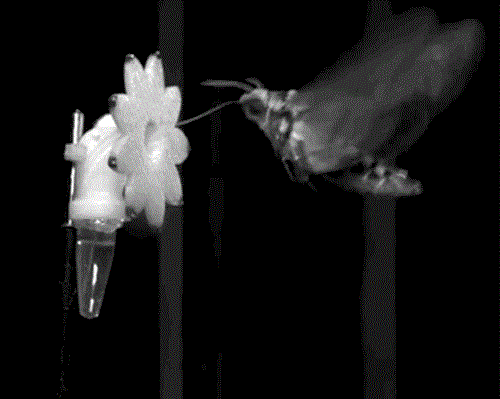Using high-speed infrared cameras and robotic flowers, scientists have learned how the hawkmoth juggles the complex sensing and control challenges of seeing in the dark, hovering in mid-air and tracking moving flowers. The work shows that the creatures can slow their brains to improve vision under low-light conditions — while continuing to perform demanding tasks.
It’s difficult enough to see things in the dark, but what if an extra task of hover is added. Is it possible to hover in mid-air while tracking a flower (in dark) moving in the wind? That’s the challenge the hummingbird-sized hawkmoth (scientific name: Manduca sexta) overcame while feeding on the nectar of its favourite flowers.
Using high-speed infrared cameras and 3-D-printed robotic flowers, scientists have now learned how this insect juggles these complex sensing and control challenges — all while adjusting to changing light conditions. This work of researchers can help to navigate our vision to the next generation of small flying robots operate efficiently under a broad range of lighting conditions.
There has been a lot of interest in understanding how animals deal with challenging sensing environments, especially when they are also doing difficult tasks like hovering in mid-air. This is also a very significant challenge for micro air vehicles.
Scientists already knew that the moths, which feed on flower nectar during the evening and at dusk and dawn, use specialized eye structures to maximize the amount of light they can capture. But they also surmised that the insects might be slowing their nervous systems to make the best use of this limited light. But if they were slowing their brains to see better, wouldn’t that hurt their ability to hover and track the motion of flowers?
Researchers then focused on this question using high-speed infrared cameras and nectar-dispensing robotic flowers that could be moved from side-to-side at different rates. While varying both the light conditions and the frequency at which the flowers moved, the researchers studied how well free-flying moths kept their tongues — known as proboscises — in the flowers.
They also measured real flowers blowing in the wind to determine the range of motion the insects had to contend with in the wild. Researchers expected to see a trade-off with the moths doing significantly worse at tracking flowers in low light conditions. But researchers saw something unexpected, the moths did slow down, that only made a difference if the flower was moving rapidly — faster than they actually move in nature.
In the experiments, the moths tracked robotic flowers that were oscillating at rates of up to 20 hertz — twenty oscillations per second. That was considerably faster than the two-hertz maximum rate observed in real flowers. Because the moth’s wings beat at a rate of about 25 strokes per second, they had to adjust their direction of movement with nearly every wingstroke — a major sensing, computational and control accomplishment.
This is really an extreme behaviour, though the moth makes it look simple and elegant. To maneuver like this, is really quite challenging for programmers and designers. It’s an extreme behaviour from both a sensory and motor control perspective for mechanical simulation tasks.
In the natural world, light intensity varies 10 billion-fold from noon on a sunny day to midnight a cloudy evening. Operating in that range of luminosity is a challenge for both moths and the sensors on human-engineered systems. Understanding how natural systems adjust to this range of conditions could therefore have broader benefits.
Working towards robots or machine vision systems that are working under this broad range of conditions, understanding how these moths function under these varying light conditions would be very useful.
Researchers used a robotic flower able to move in one dimension. Recently, they’ve used the actuator devices from a 3-D printer to build a robotic flower that moves in two or three dimensions, providing an additional challenge for the moths. Researcher further expanded their research by incorporating their robotic flower into a low-speed wind tunnel to study the aerodynamic challenges the moths overcome — including the role of wing vortices and the flow-effect interaction of the insect’s wings with the flowers.
The hawkmoth has been studied extensively to investigate the fundamental principles governing the development and function of its neural system. By aerodynamic analysis, researchers experimentally characterized the response of flying hawkmoths, using a sensory input composed of the linear sum of sine waves.
The work took the formal methods of control theory to dissect out how neural circuits adapt to vast ranges of luminance levels. By looking at the time delays in the movement dynamics of a freely-flying moth — interacting with the input of a robotically moved flower — Scientist were able to extract the luminance dependent processing of the moth’s central nervous system.
Human engineered devices must often operate at various speeds and in different environments. Seeing how well an animal with a tiny brain was able to track complicated movements and adjust its performance to different light levels was a surprising result of the work.
This was an interesting example of how an organism can tune its brain to maintain its ability to gather food. The moths do suffer a trade-off by slowing their brains, but that trade-off doesn’t end up mattering because it only affects their ability to track movements that don’t exist in the natural way that flowers blow in the wind.

